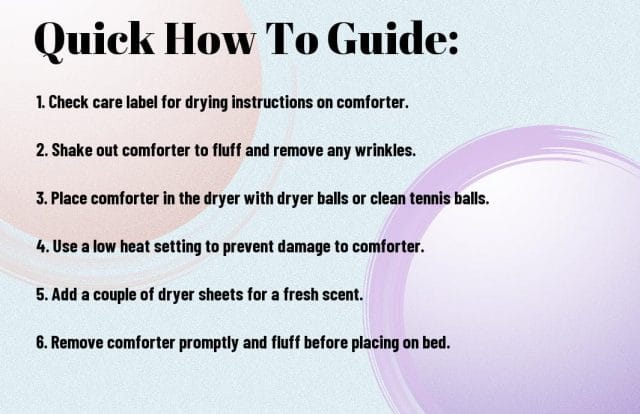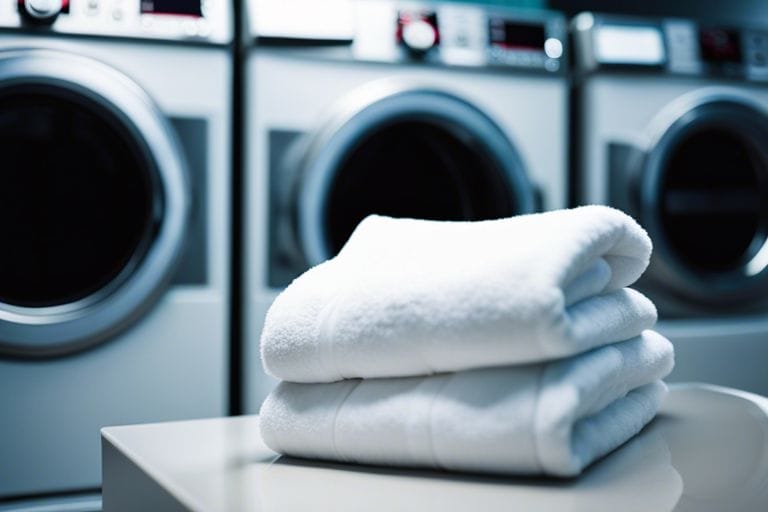Have you ever wondered if it’s safe to put your comforter in the dryer without damaging it? If so, you’re in the right place! Putting a comforter in the dryer can be a convenient way to get it clean and fluffy, but there are some important precautions you need to take to avoid damaging the fabric or causing a fire hazard. In this guide, we’ll walk you through the essential steps to safely dry your comforter without any mishaps.
If you’re interested in learning how to wash and dry a comforter in 8 steps, you’ll find this guide extremely helpful. So, let’s get started!
Key Takeaways:
- Use a large capacity dryer: Ensure your dryer is big enough to accommodate the comforter without overcrowding.
- Use low heat setting: Opt for a low heat setting to prevent damage to the fabric and filling of the comforter.
- Use dryer balls or tennis balls: Add dryer balls or tennis balls to the dryer to fluff up the comforter and prevent clumping.
- Check for dryness periodically: Stop the dryer every so often to check if the comforter is drying evenly and prevent overheating.
- Be mindful of the material: Different materials require different care, so always refer to the care label on the comforter for specific drying instructions.


Preparing Your Comforter for the Dryer
Before putting your comforter in the dryer, there are a few important steps to take to ensure it comes out clean, fluffy, and undamaged. Some comforters may require special care due to their size, material, or filling, so it’s essential to prepare them properly.
Checking the Care Label
Some comforters may have specific care instructions on their labels, so it’s crucial to check these before proceeding. The care label will typically provide guidance on the appropriate washing and drying methods for your comforter. For example, it may indicate whether the comforter is machine washable or if it requires special handling. It may also include information on the recommended water temperature, detergent type, and drying temperature. Following the care label’s instructions is important to avoid damaging your comforter and ensure it retains its quality for the long term.
Spot-Cleaning Stains
If your comforter has any visible stains, you should address these before putting it in the dryer. You can spot-clean stains using a gentle detergent and a soft brush or cloth. Simply apply a small amount of the detergent to the stained area and gently agitate the fabric to lift the stain. After spot-cleaning, make sure to rinse the area thoroughly to remove any remaining detergent residue. This step will help prevent the stains from setting in during the drying process.
Ensuring Even Weight Distribution
Before placing your comforter in the dryer, it’s important to distribute the filling evenly to prevent clumping and ensure thorough drying. If your comforter has shifted filling or areas of uneven thickness, gently pat and shake it to redistribute the filling. This will help the comforter maintain its loft and shape during the drying process, resulting in a more even and fluffy finish.
Selecting the Right Dryer Settings
Now that you have your comforter loaded in the dryer, it’s important to select the right settings to ensure it comes out fluffy and fresh. Properly setting your dryer will not only ensure the comforter dries thoroughly but also prevent damage to the fabric and filling material. Here’s how to select the right dryer settings for your comforter.
Determining Appropriate Heat Levels
When drying your comforter, it’s crucial to use the right heat level to avoid damaging the fabric and filling. **You should always use a low or medium heat setting** to minimize the risk of overheating and damaging the fabric. High heat can cause shrinkage and damage to the filling, leading to lumps and uneven distribution. Always check the care label on the comforter for any specific heat level recommendations.
Setting the Timer and Other Features
Setting the timer and other features on your dryer is also important when drying a comforter. **You should set the timer for a longer duration** to ensure the comforter dries thoroughly without overheating. Additionally, consider using **the delicate or low-tumble setting** to prevent excessive agitation, which can damage the fabric and filling. If your dryer has an option for a cool-down cycle at the end, this can also be beneficial in preventing overheating and reducing wrinkles.
Tips for Optimal Drying
Despite the convenience of using a dryer, it’s important to use it safely and efficiently. Here are some tips to ensure your comforter is dried effectively and without damage:
- Use a large dryer – if you have a bulky comforter, a large capacity dryer will allow for better air circulation and more even drying
- Check the dryer’s heat settings – opt for a gentle or low-heat setting to prevent damage to the comforter’s fill and fabric
- Include dryer balls or tennis balls – these help to fluff the comforter as it dries, preventing clumping and ensuring even drying
- Periodically check the comforter – stop the dryer and check the comforter’s progress to avoid over-drying or potential damage
Assume that these tips will help you achieve the best results when drying your comforter in the dryer.
Using Dryer Balls or Tennis Balls
Adding dryer balls or tennis balls to the dryer can help to fluff and evenly distribute the comforter as it dries. The balls bounce around in the dryer, preventing the fill from clumping and ensuring that the comforter dries evenly. This is especially important for larger or thicker comforters that may be prone to retaining moisture in certain areas.
Periodically Fluffing the Comforter
During the drying process, you can stop the dryer and fluff the comforter by hand or gently shake it to redistribute the fill and prevent clumping. This helps to ensure that the comforter is drying evenly and prevents moisture from becoming trapped in certain areas, which can lead to a musty odor or potential damage over time.
Recognizing When the Comforter is Fully Dry
When the drying cycle is nearing completion, you should check the comforter periodically to ensure that it is drying evenly. You can do this by feeling different areas of the comforter to make sure they are all completely dry to the touch. This will prevent the comforter from being over-dried, which can lead to unnecessary wear and tear on the fabric and fill.
 Factors to Consider for Comforter Longevity
Factors to Consider for Comforter Longevity
After investing in a high-quality comforter, you want to make sure it lasts for as long as possible. To extend the longevity of your comforter, there are several factors you need to consider:
- Fabric Type: The type of fabric your comforter is made of plays a significant role in its longevity. Natural fibers like cotton and wool are durable and long-lasting, while synthetic materials like polyester may not hold up as well over time.
- Fill Quality: The quality of the fill material in your comforter, whether it’s down, feathers, or a down alternative, will also impact its lifespan. Higher quality fill will resist clumping and maintain its loft better over time.
- Construction: The construction of the comforter, including the stitching and quilting pattern, can affect its durability. Look for well-constructed comforters with reinforced edges and tight stitching to ensure longevity.
Any of these factors can contribute to the overall lifespan of your comforter, so it’s essential to consider them when caring for your bedding.
Frequency of Washing and Drying
When it comes to maintaining the longevity of your comforter, how often you wash and dry it can have a significant impact. Washing and drying your comforter too frequently can cause unnecessary wear and tear, leading to a shorter lifespan. Conversely, infrequent cleaning can allow dust mites, allergens, and dirt to accumulate, impacting the comforter’s overall quality. To strike the right balance, aim to wash and dry your comforter every 6-12 months, or as needed. Spot cleaning stains and regularly airing out your comforter can also help maintain its freshness between washes.
Storage Solutions
Proper storage is crucial for maintaining the longevity of your comforter. When not in use, avoid cramming your comforter into a tightly packed storage space, as this can compress the fill and affect its loft. Instead, consider storing your comforter in a breathable cotton or linen storage bag, allowing it to breathe and maintain its fluffiness. Additionally, storing your comforter in a cool, dry place away from direct sunlight can prevent the fabric from deteriorating over time. By investing in the right storage solutions, you can help prolong the life of your comforter and ensure it continues to provide warmth and comfort for years to come.
Conclusion
To wrap up, putting a comforter in the dryer safely is crucial to maintain its quality and avoid damaging the fabric. By following the proper steps such as using a large capacity dryer, adding dryer balls or tennis balls to fluff the comforter, and adjusting the heat setting to low, you can ensure that your comforter is thoroughly dried without being subjected to excessive heat. Remember to check the care label for any specific instructions and always use a gentle detergent to wash your comforter before drying. By taking these precautions, you can safely dry your comforter and prolong its lifespan.
FAQ
Q: What is the proper way to put a comforter in the dryer?
A: To safely put a comforter in the dryer, start by ensuring that the comforter is suitable for machine drying. Place the comforter in the dryer with a couple of clean tennis balls or dryer balls to help fluff it up. Use a low heat setting to prevent overheating and potential damage to the comforter. As it dries, periodically check the comforter and fluff it to ensure even drying.
Q: Can I use dryer sheets when drying a comforter?
A: It is not recommended to use dryer sheets when drying a comforter. The chemicals and residue from the dryer sheets can potentially damage the fabric of the comforter. Instead, consider using clean tennis balls or dryer balls to help fluff the comforter and prevent clumping during the drying process.
Q: What are the precautions to take when drying a comforter in the dryer?
A: When drying a comforter in the dryer, it is important to ensure that the dryer is large enough to accommodate the size of the comforter. Avoid overloading the dryer, as this can lead to uneven drying and potential damage to the comforter. Additionally, it is important to check the care label on the comforter for any specific instructions regarding machine drying. Always use a low heat setting to prevent overheating and shrinking of the comforter.

